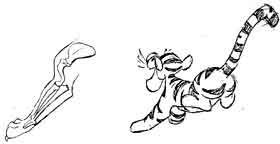Audiences like to see a quality of charm, pleasing design, simplicity, communication, or magnetism. A weak drawing or design lacks appeal. A design that is complicated or hard to read lacks appeal. Clumsy shapes and awkward moves all have low appeal. In creating an appealing pose for a character, one thing to avoid is called "twins", where both arms and both legs are in the same position, doing the same thing. This creates a stiff pose that is unappealing. Vary the parts of the body a bit, including the facial features, makes a character more appealing.
Thursday, 25 November 2010
Secondary Action
A secondary action is an action that results directly from another action. Secondary actions are important in heightening interest and adding a realistic complexity to the animation.
If a secondary action conflicts with, becomes more interesting, or dominates in any way, it is either the wrong choice or is staged improperly.
If a secondary action conflicts with, becomes more interesting, or dominates in any way, it is either the wrong choice or is staged improperly.
Straight ahead action and pose to pose
Straight Ahead Action in hand drawn animation is when the animator starts at the first drawing in a scene and then draws all of the subsequent frames until he reaches the end of the scene. This creates very spontaneous and zany looking animation and is used for wild, scrambling action.
 Pose-to-Pose Action is when the animator carefully plans out the animation, draws a sequence of poses, i.e., the initial, some in-between, and the final poses and then draws all the in-between frames (or another artist or the computer draws the inbetween frames). This is used when the scene requires more thought and the poses and timing are important
Pose-to-Pose Action is when the animator carefully plans out the animation, draws a sequence of poses, i.e., the initial, some in-between, and the final poses and then draws all the in-between frames (or another artist or the computer draws the inbetween frames). This is used when the scene requires more thought and the poses and timing are important
 Pose-to-Pose Action is when the animator carefully plans out the animation, draws a sequence of poses, i.e., the initial, some in-between, and the final poses and then draws all the in-between frames (or another artist or the computer draws the inbetween frames). This is used when the scene requires more thought and the poses and timing are important
Pose-to-Pose Action is when the animator carefully plans out the animation, draws a sequence of poses, i.e., the initial, some in-between, and the final poses and then draws all the in-between frames (or another artist or the computer draws the inbetween frames). This is used when the scene requires more thought and the poses and timing are important
Tuesday, 23 November 2010
Cycles
Walk cycles are created frame by frame. They are a sequence of images in which link back to the beginning. A walk cycle consists of a moving character and one stride can usually take 8 frames.
Walk cycles are one of the hardest things to master however when achieved u can use the other principles to enhance rhythm, force, mass and other such attributes.
Eadweard Muybridge first began to break down the stages of walk cycles in 1872 when he investigated whether all four of a horse's hooves are off the ground at the same time during a gallop; his most famous work of the horse in motion. He then went on from this to break down movements of other animals and the human figure. Looking into rhythm and movement you are able to break down the body's anatomy and shape a great help in recapturing realism in animation.
Squash and Stretch
Squash & Stretch is used in animation do add emphasise and effect. It is a technique applied to an object or character in motion. It is mainly used in cartoon animation for exaggeration. Its use adds fluidity to make movements look more realistic.
Squash and stretch can be use to emphasise expression and bring focus to a particular part of the animation.
for objects movement it can add fluidity and ceate a realistic approach it adds weight to the object ass it moves.
Squash & Stretch is used in animation do add emphasise and effect. It is a technique applied to an object or character in motion. It is mainly used in cartoon animation for exaggeration. Its use adds fluidity to make movements look more realistic.
Squash and stretch can be use to emphasise expression and bring focus to a particular part of the animation.
 |
| fanart.lionking.org |
 |
| foundationsofanimation.wordpress.com |
Timing
Timing in animation is mainly made up of 24 or 25 frames per second. Timing assimulated how quickly or slowly movement take place.
Timing can determine the mood and realism of the film. If done correctly in can impose weight and power to an object. Without good timing an animation can fall apart, having a very fast walk can appear as a run or no movement at all.
Subscribe to:
Posts (Atom)







